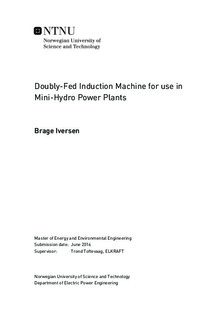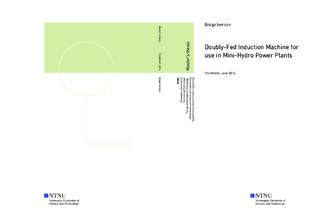| dc.description.abstract | In hydro power applications, the synchronous generator is widely used. As the speed of the synchronous generator is fixed to the frequency of the grid, the hydro turbine must operate at fixed speed independent of load and water flow. Earlier studies of the topic have concluded that the efficiency of the turbine can be increased by introducing a variable speed generator.
The doubly-fed induction generator (DFIG) is widely used in wind power applications and is capable of operating at speeds +/-30% around synchronous speed. However, this introduces a power electronic converter for controlling the rotor currents and slip rings are used for transferring the power into the rotor circuit. This adds complexity to the system which may cause needs for more maintenance and more expensive equipment.
This work continues a work started in a Master thesis in 2015, where the control strategies for a DFIG used in hydro power applications were developed. Simulations were used to study the behavior of the configuration, and a lab setup where a asynchronous motor was used as turbine was made.
The lab setup is improved and the complete control system is rebuilt. A Speedgoat real-time controller is chosen as the controller for the lab setup. The programming of the controller is done by the use of Simulink, which is a well known tool for simulations. The signal conditioning system for speed, voltage and current measurements and solutions for interfacing the converters are made from scratch. The motor drive controlling the asynchronous motor which is used for simulating the turbine, is controlled by the Speedgoat controller.
Through lab tests, the functionality of the lab setup is verified by changing speed and torque. The result of the work, is a lab setup which can be used for testing the DFIG in a hydro power application. Since the hardware is made and found to be working well, it is possible to develop the setup further in the future mainly by doing improvements in software. | |

